Review GSM phone Pantech GF500
Package:
- Handset
- Battery
- Charger
- Manual
It is an open secret that several models by a manufacturer could have the same platform. Some companies' step is produced by the keen competition in the mobile phone market. In order to attract customers as many as possible manufacturers put out models in various bodies which usually have the same hardware and software. And the company of Pantech has indeed put out two phone models, equal in functionality, in the most popular form-factors that are a slider (PG-3000 reviewed earlier) and a clamshell GF500.

As noted above, GF500 is a clamshell with two colour screens. Its dimensions are not so large 89x46x22.3 mm and the weight equals 90 g. The phone body is taken the shape of a trapezium and the upper and lower ends are bevelled at an angle of 45 degrees. The edges are slightly smoothed so that the form stands out against the background of other phones. The handset fits a hand well and opening the device poses no trouble thanks to hollows on the sides. There is a rubber plate between the halves and it is designed to protect the body against damage while opening.

The model PG-3000 has the body being entirely silvery and as distinct from that the colours of GF500 are black and silvery combined. The black covering of the upper part front panel is lacquered and fingerprints are certain to be left, however they are not seen very much. The covering quality is quite good and the dye does not peel in the course of time, yet nobody is assured against any scratches. They are especially visible on the back cover which is of silvery and almost all phones with such covering suffer from the defect. There is no censure to the plastic and assembling quality as everything is up to standard.
The upper cover has a colour TFT screen of the resolution of 128x160 pixels (19x23 mm) which is capable of showing 262K colours. The screen is bright and owing to the high resolution the image looks quite good, this relates to both optimised images and photos. It fades in the sunshine, information remains readable nevertheless.
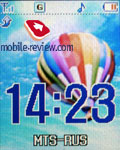
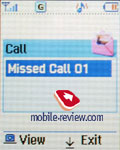
At an incoming call a photo is shown full-screen and the subscriber's number or name and group are indicated. The screen could also serve as a viewfinder in case you like to take a self-portrait.


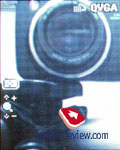
The external screen has its own menu that possible by pressing and holding down the side key. It consists of four items: profiles, last calls, incoming messages, and IrDA gap. A switch between items is done with the side volume keys and the camera key is a confirmation one. This menu is very handy, for instance: you do not have to open the device to read a new message and a profile can be shifted at once. The only defect is the too small text that, unfortunately, may not be enlarged and hence this function is destined for people with good eyesight.
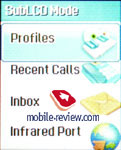
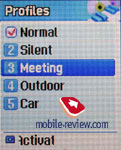
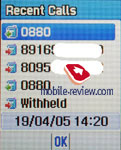
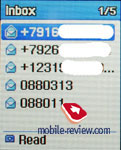
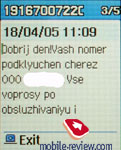

You can select one of four offered clock types (2 digital and 2 analogue ones) in the Settings menu for the external screen. There are also 10 preset wallpapers including 3 animated ones.
Besides, the settings contain the item Graphic equaliser and if it is turned on, at an incoming or outgoing call the external screen will show an image. This function lacks functionality whereas it affects the battery life. Although considering that while the handset open the external screen does not turn off and shows the company's logo, the graphic equaliser could be turn on, especially in case you are anxious to attract attention to you.
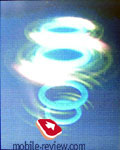

Moreover the upper half has a flash that is very good to be used as a torch. It can be activated with pressing and holding up the volume key when the device is folded. However if you are going to use it a torch, do not forget that it turns off in 15 seconds and you will have to switch on newly. There is a lens of a 1.3 megapixel camera a little below the flash.

The left side surface has a camera key, a coupled volume key and an IrDA gap. There is merely a headset connector shielded with a rubber shutter fixed to the body on the right side surface.

There is a service indicator on the top underneath a black plastic insert. An interface connector shielded with a rubber shutter is traditionally placed on the bottom. And in contrast to PG-3000 whose shutter turns up aside while being opened, the shutter of GF500 slides out - you should just hook and draw it toward you. This conformation enables to avoid the problems faced by PG-3000 that the shutter did not fix in close state.

After opening the phone you can see the internal screen (TFT) with the resolution of 128x160 pixels (28x35 mm) and capable of showing 262K colours. The screen has its brightness and contrast artificially raised and so the image looks unnatural. Compare to Samsung D500's screen, it gains by brightness and loses by image accuracy and naturalness.
The screen's feature consists in the fact that it has small observation angles and when there is a little declination (especially vertically) colours start to be distorted. But then in the sunlight information on it can be read in any position.

The phone keypad is handy and a fourway navi button with an integrated OK is somewhat elongated. Two softkeys, receive and a reject keys, and a cancel one are well arranged and handy.
The number keys are placed tight, although they are quite large in size so that mistypes occur rarely. The keys suit both Russian and Latin characters. The purple backlight is well distributed.

The rest of the back cover is occupied by an accumulator battery that also serves as a back cover. It has a small move due to the weak fixing. According to the manufacturer, the Li-Ion battery of the capacity of 680 mAh provides up to 3.5 hours in talk mode and up to 200 hours in standby mode. In the condition of Moscow MTS network the handset has worked for 2 days in case of 30 minutes of talks a day and up to 20 minutes of using other functions.

Menu
The main menu is represented in two variants. In the first case three rows of three icons are shown, the selected item is highlighted and its title is reprinted above. In the second case the screen shows one big icon with an explaining inscription and the item number below as well as small icons of the further items. Both appearances are of interest and, after a variant is chosen, the submenu colouring changes as well. The former suggests blue and the latter is of purple. The submenu is represented as vertical lists and has a quick navigation using number sequences. Some sub-items do not requires entering, for the information of actions that could be taken shows at the foot of the screen and an action is selected by navi button horizontal deviation.
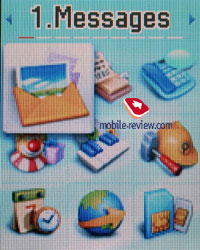
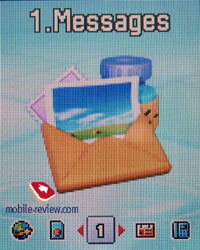

The menu localisation is carried out at mean level. Some titles are abbreviated and this is not so acceptable. By the time of this review the next version of the model which has some localisation drawbacks corrected had been put out.
The phone has 8.4 Mb of embedded memory that is dynamical distributed among applications.
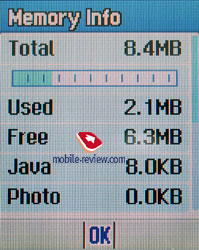
Phone book. The device holds up to 800 numbers. Entries are shown both separately from the phone memory or SIM-card and altogether. Each entry could have name, up to four numbers, and e-mail. Moreover you may assign a ring tone, a photo or a video to show at a call and put into one of ten caller groups. One can either use 4 existed groups or create a new one. Any group has a name of up to 19 characters and a ring tone.
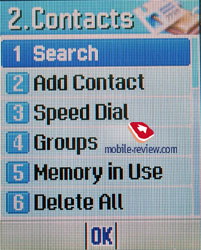
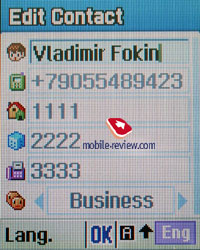
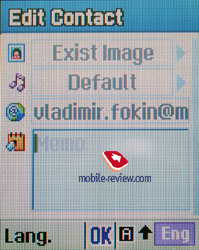

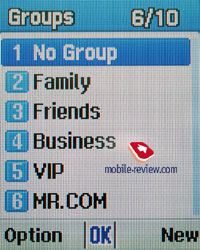
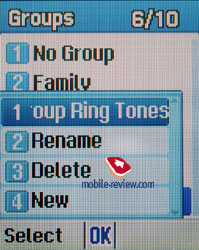
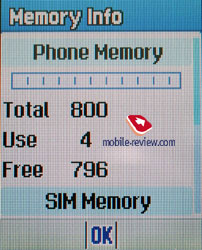
There is a speed dialling of up to 99 numbers. A search in the phone book is made by a name, group, and photo (video) as well as speed dialling number.
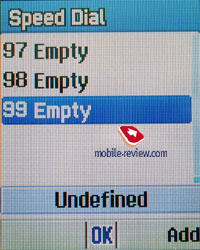
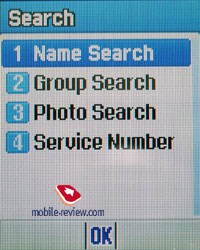
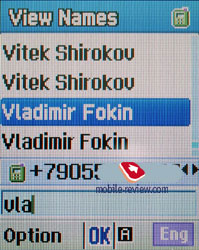
At an incoming call photos or videos assigned to callers show full screen and the name (if the number is contained in the phone book) and group title.

Messages. The device supports EMS standard and hence has a set of small images, animation, and melodies to add to the message body. There preset text templates and an opportunity of creating own ones. The MMS editor is clear and simple.
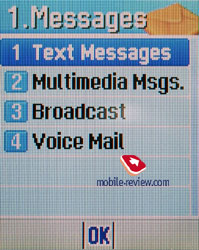
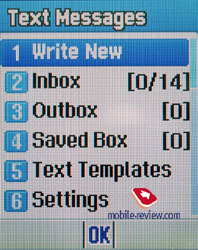
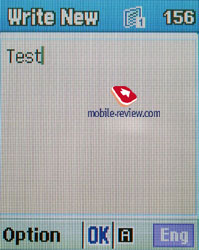
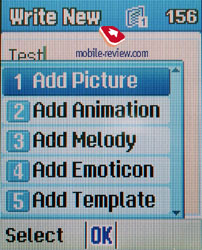
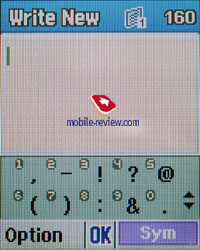
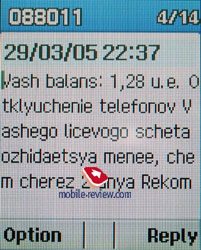
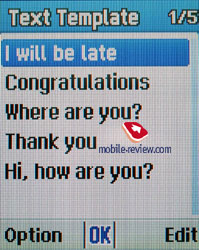
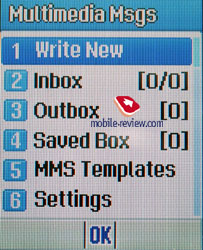

Mere three melodies are available for message alerts and a repetition could be set for every two or five minutes.
Call list. Here you can view the information of dialled, received and missed calls. The equal numbers do not combines and show one by one.
Profiles. There is an offer of 5 adjustable call profiles.

Settings. This holds everything concerned with the phone, network, screen, sound, and other settings. One of preset images or animations and any image uploaded by the user or taken with the camera can be assigned as a wallpaper. You may also choose a screensaver in standby mode. One of the offered variants of clock and calendar displaying is to be chosen for the main screen. The backlight time runs from 5 seconds to 10 minutes.
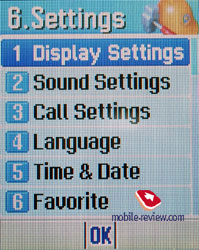

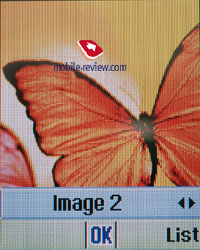
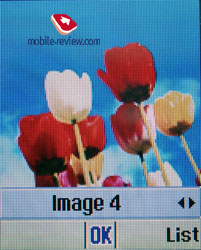
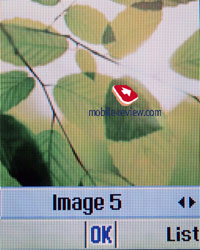
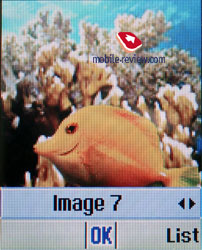
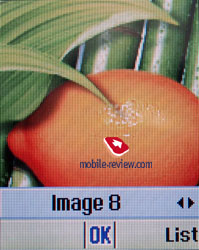
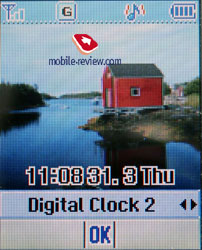
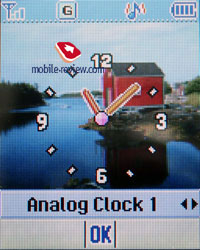
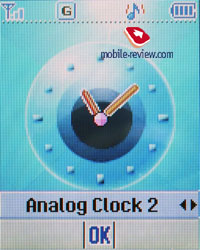
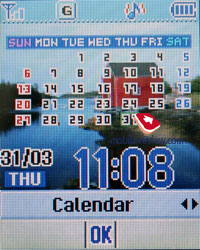
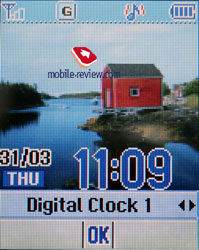
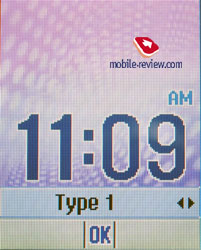
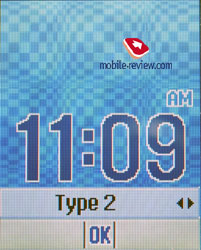
The sound settings contain a call type - vibra, signal, progressive signal, vibra and signal altogether, first vibra and then signal. Various signals could be assigned to almost every action.
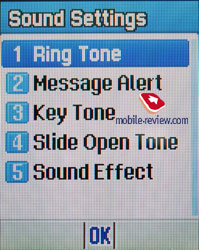
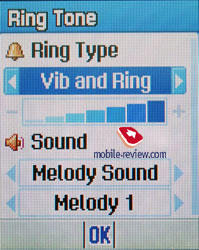
You can upload your pictures and MP3 melodies to the device, yet there is a restriction on the capacity of a transmitting object - 300 Kb.
There is also the menu 'Favourites' - this is the user's own menu for a quick access to frequent used functions. In standby mode it is possible by a navi button left deviation.

Organizer. Alarm-clock. You may set 5 independent alarm-clocks and each of them could activate once, daily or from Monday till Friday (till Saturday).
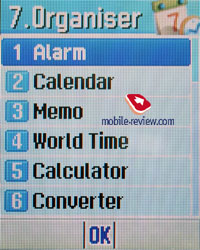
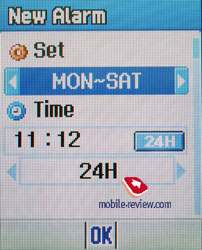
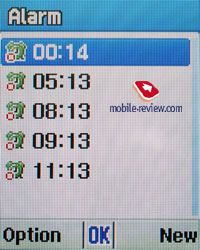
Calendar. A view of either a whole month or the all event list is possible. An event has a mark (birthday, meeting, trip etc.), time, a text note, an alert, activation time (in time or in a period from 15 minutes to 1 day before the event). You can also determine an event repetition - once, every month, every year. There is a limitation of 50 messages in all.
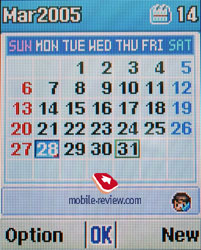
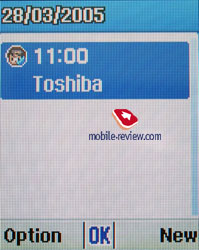

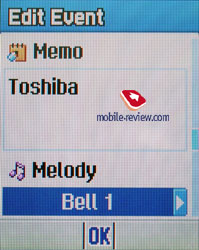
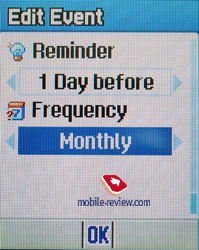
Notebook. Creating text notes of up to 255 characters is possible.
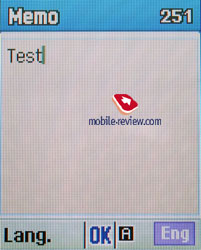
Besides, the device has a world time, a simple calculator, a unit convector, a stopwatch (up to 5 intermediate values), and a timer.
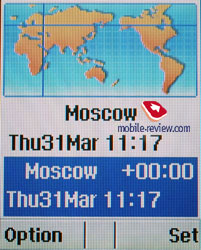
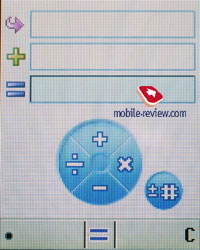
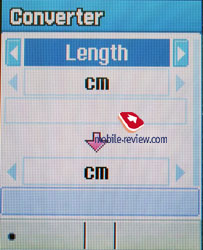
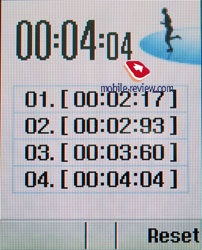

Fun and Tools. Camera. The handset supports several resolutions - SXGA (1280x1024), VGA (640x480), QVGA (320x240), LCD (128x160).A number of pictures is also to be determined - Fine, Normal, Low. Taking a series of from 4 to 15 pictures in a certain period is possible. The flash can be in automatic operation mode, online or in off mode. The flash is not worth anything special to say since it is rather a bright torch and would little help while taking photos in the dark. Pictures are saved to the default folder, otherwise you should create your own folders. Photos of high resolution and quality are being saved for a long time (15-20 seconds approximately).
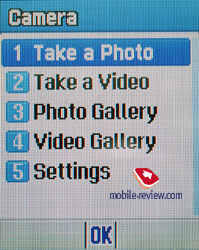
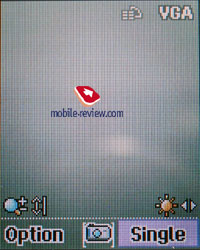
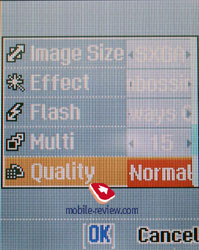
The menu is possible by pressing the left softkey. The timer is set up to 5 seconds. Moreover there are 10 accessible frames to put on a picture. Besides, you can turn on a time and date function that superimposes them on a photo.
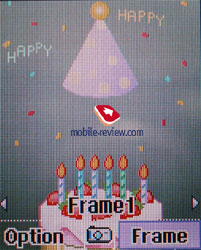
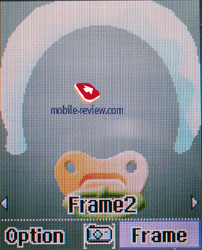
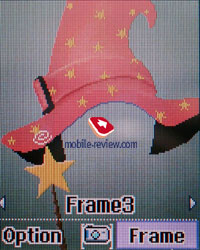
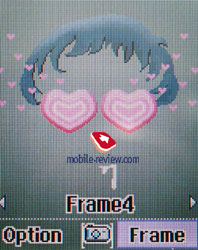
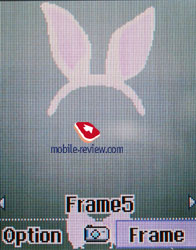
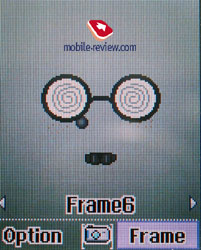
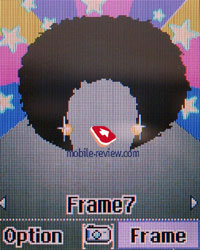
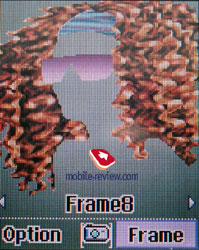
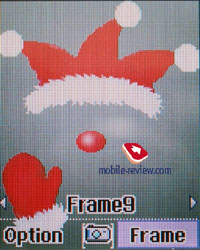
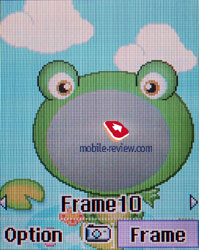
A left or right deviation of the navi button adjusts brightness and an up or down pressure activates the 10x digital zoom.
Sample
zoom working in a file – 747 KB, ZIP>>>
The device has some effects - Warm, Sepia, Antique, Cool, Moonlight, Fog, Negative, Grayscale, Embossia.
Effects in an archive, ZIP, 2.77 MB >>>
Taken photos are of good quality, yet have some natural colours distorted a bit and the image becomes darker. The picture edges get out of focus and are some blurred. The picture quality stands between those of Sony Ericsson S700 and Samsung D500. It does not reach the quality of S700 a little and being undoubtedly better than D500's one. So I suggest viewing a picture series taken by these three devices.
Sample
photo outdoors, 1280x1024, Fine, 323 KB, JPEG
Sony
Ericsson S700; Samsung
D500
Sample
photo outdoors, 1280x1024, Fine, 304 KB, JPEG
Sony
Ericsson S700; Samsung
D500
Sample
photo outdoors, 1280x1024, Fine, 330 KB, JPEG
Sony
Ericsson S700; Samsung
D500
Sample
photo outdoors, 1280x1024, Fine, 246 KB, JPEG
Sony
Ericsson S700; Samsung
D500
More photos taken with GF500:
Sample
photo outdoors, 1280x1024, Fine, 160 KB, JPEG
Sample
photo outdoors, 1280x1024, Fine, 302 KB, JPEG
Sample
photo outdoors, 1280x1024, Fine, 169 KB, JPEG
Sample
photo outdoors, 1280x1024, Fine, 172 KB, JPEG
Sample
photo outdoors, 1280x1024, Fine, 187 KB, JPEG
Sample
photo outdoors, 1280x1024, Fine, 223 KB, JPEG
Sample
photo outdoors, 1280x1024, Fine, 182 KB, JPEG
Indoors in daylight or candlelight as well as outdoors in overcast weather the picture quality decreases.
Sample
photo outdoors, 1280x1024, Fine, 244 KB, JPEG
Sample
photo indoors, 1280x1024, Fine, 283 KB, JPEG
Sample
photo indoors, 1280x1024, Fine, 159 KB, JPEG
Any picture can be transmitted to a PC using an IrDA gap alright.
The device permits recording video sound-films in MJPEG format of the resolution of 128x160 pixels. A film of about 9 seconds takes 265 Kb approximately. When a playback they are played full screen with no breaks. Video films could not be transferred to a PC or sent by MMS as they can only serve as a wallpaper or be assigned to phone book entries.

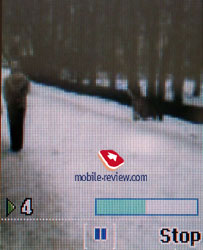
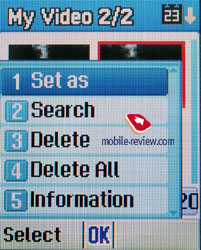

Media gallery. This contains folders of photos, videos, images and sounds. Here you may also see the information about free and used memory.
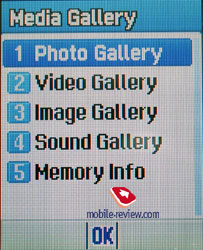
Games. The device has one preinstalled logic game Smokey.

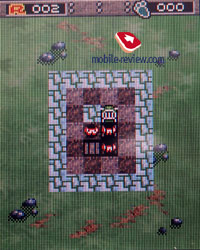
Java. The handset supports MIDP 2.0. There is a preset arcade game Aqua. Installing other ones has run with no trouble.
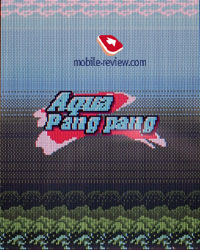
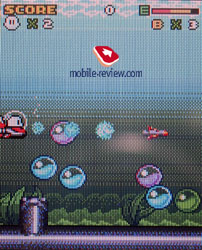
Answerback drum. The device has a preset answerback drum that you can adjust to you with recording a hello message or selecting a preinstalled one (meeting, driving etc.) and determining an activating time in a period from 3 to 20 seconds. This function will attract subscribers whose tariff scale provides free incoming calls in order to save on voice mail. A rapid access to this function is made in the following way: while the phone is open you should press and hold the volume key.
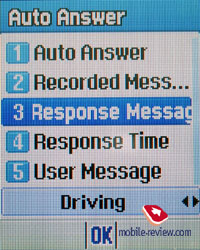
Voice notes. This allows creating voice records of up to 30 seconds.

Connections. This menu holds an access to a WAP browser of 2.0 version and IrDA settings which have several modes - Internet connections, PC synchronization, object transmission.
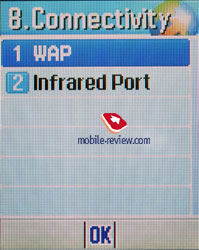

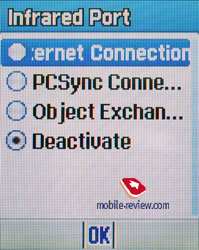
Impressions
The device is quite good in connection quality even though there used to be some moments when an interlocutor complained of that the voice sounded muffled. The quality of 64-voice polyphony is rather good and the alert volume suffices so that a call cannot but be heard. The vibracall is modest in power and sometime you could miss it.
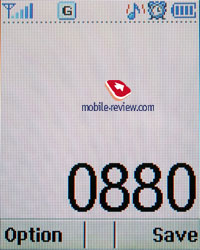

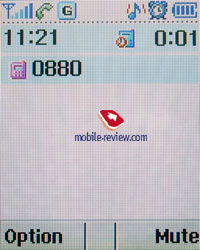
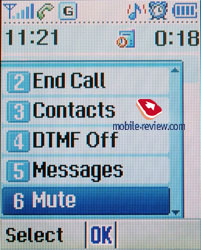
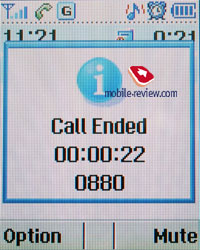
In the first place the handset will attract with the design that draws attention and does not resemble that of rival products. The menu realisation is handy and one will soon get accustomed to it. The preset 1.3 MP camera has done justice to itself as it permits taking pictures of adequate quality. The presence of Java and assigning MP3 to ring tones form an advantage. The external screen of high resolution and small dimensions will appeal to proper people, rather people with good eyesight.
Disadvantages include the battery move which, though small, annoys
a great deal. Besides, we should mention the shortcomings of PG-3000.
They are the long time of picture saving, the installed memory
capacity of 8.4 Mb which is not so big, considering the 1.3 M
camera presence, assigning MP3 to ring tones and installing Java-application;
and what is more ,video films of MJPEG could be used only on the
phone and not be transmitted anywhere.
The models Pantech PG-3000 and GF500 are quite interesting and
can certainly compete with Samsung products. It is more likely
if the fact that their nowaday price are within 400 USD is regarded.
To be precise, PG-3000 costs about 320 and 10 USD more expensive,
in Moscow. These prices will remain for rather a long time.
Melody samples (mp3, 324 KB)
Vladimir Fokin (vladimir.fokin@mobile-review.com)
Translated by Maria Mitina (maria.mitina@mobile-review.com)
Published - 21 April 2005
Have something to add?! Write us... eldar@mobile-review.com
|












































































































